What We Mean by “Dehydrate”
Here at Easy Food Dehydrating, “dehydrate” always means using an electric food dehydrator — the easy, reliable way to dry food at home.
- Home
- Dehydrating Vegetables: Step-by-Step Guides by Type
- How to Dehydrate Butternut Squash
How to Dehydrate Butternut Squash
(Fresh or Frozen)

Dehydrating butternut squash is a simple way to preserve this sweet, nutty vegetable so it’s always on hand for soups, stews, and even homemade dog food. Once dried, it stores beautifully for months and saves freezer space.
✅ Quick Answer: How do you dehydrate butternut squash?
Peel, cube, and lightly steam butternut squash, then spread pieces on dehydrator trays. Dry at 125–135°F for 7–10 hours until leathery. For frozen squash, skip peeling/steaming and dehydrate directly. Store in airtight jars or vacuum-sealed bags for long-term use.
Whether you start with fresh squash or grab a bag of frozen cubes, the process is quick and rewarding. Below, I’ll walk you through the exact steps so you can enjoy butternut squash long after harvest season ends.
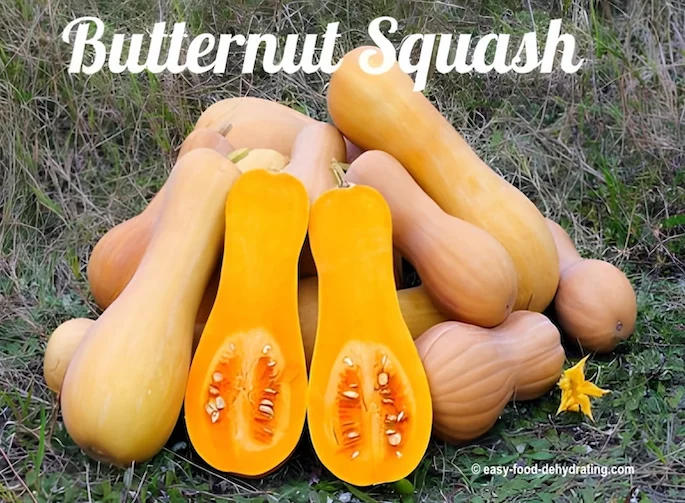
I use this veggie all the time in our doggie's dinner. Read more about making your own dog food here.
What Makes Butternut Squash So Nutritious? (Vitamins + Minerals)
VITAMINS: Loaded with Vitamin A. Also contains Vitamin C, Folate, Vitamin E, Vitamin K, Niacin, and trace amounts of Pantothenic Acid and Thiamine, so it's well worth your time and energy.
MINERALS: Potassium ranks high, followed by Calcium, Magnesium, and Phosphorus, with trace amounts of Selenium, Manganese, and Zinc.
Butternut squash also contains Omega-3 and Omega-6 fatty acids.
Exact Steps: How to Dehydrate Butternut Squash (Fresh or Frozen)
If using frozen butternut squash, ignore steps 1 and 2.
- Peel the butternut squash and cut into 3/4-inch strips, or cube it for good even-drying.
- Steam over boiling water for about 7 minutes, or until your squash is tender.
- Arrange the butternut squash on your dehydrator trays, making sure the pieces don't overlap each other.
- Turn on your food dehydrator and set the temperature between 125°F and 135°F (or per your food dehydrator's instructions) and that's all there is to it!
💡 Tip: Outside the U.S.? Most dehydrating temps here are listed in Fahrenheit - use our quick converter to see the Celsius equivalent for your machine.
- Drying time: between 7-10 hours.
- Butternut squash will be leathery in consistency when dried.
- Please remember to rotate your dehydrator trays for even drying.
Frozen Butternut Squash Shortcut (Why It Saves You Hours)
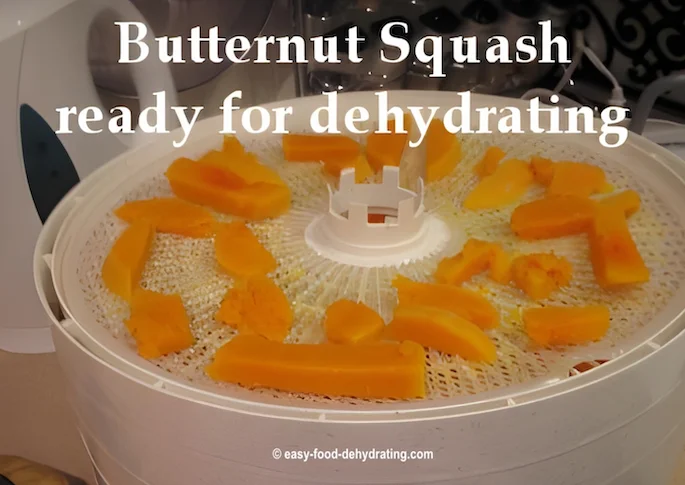
As noted in the instructions above, butternut squash is steamed
lightly first, to aid in the dehydrating process. This softens them and breaks down the outer edges, allowing moisture to escape faster. It also helps keep the squash's vibrant color!
Butternut squash makes a great soup and purées well for sauces.
As I mentioned at the top of this page, my primary use of butternut squash is for my Chicken Chow dog food for our perfectly adorable Miniature Pinscher!
I'd like to make a note here that I have not tried dehydrating puréed frozen butternut squash, but I think it would work just fine on the fruit roll sheets! Just let it thaw out first and follow the temperature guide below...
The #1 Mistake to Avoid: Uneven Cuts
I would like to add here that it's better to have even-sized pieces of the squash on the dehydrator trays—it dries out better and at the same rate, so you're NOT taking off the small pieces and still running the dehydrator to finish drying the larger pieces.
Don't let my photo of
the bigger piece of butternut squash on the dehydrator tray (shown in the previous section) lead you astray. Oops, sorry about that.. a case of "do as I say, not as I do!" LOL :-)
Should You Steam Squash Before Dehydrating? (Yes—Here’s Why)
Steaming softens the squash so moisture escapes faster, shortens drying time, and helps preserve that gorgeous golden color.
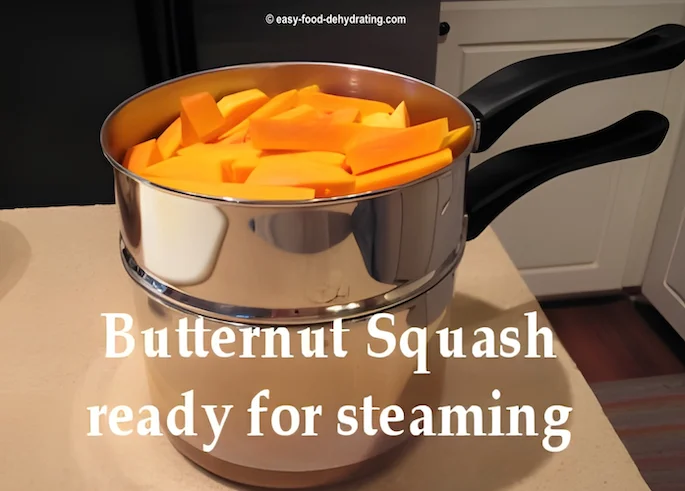
Spot the Signs: How to Tell When Butternut Squash is Fully Dry
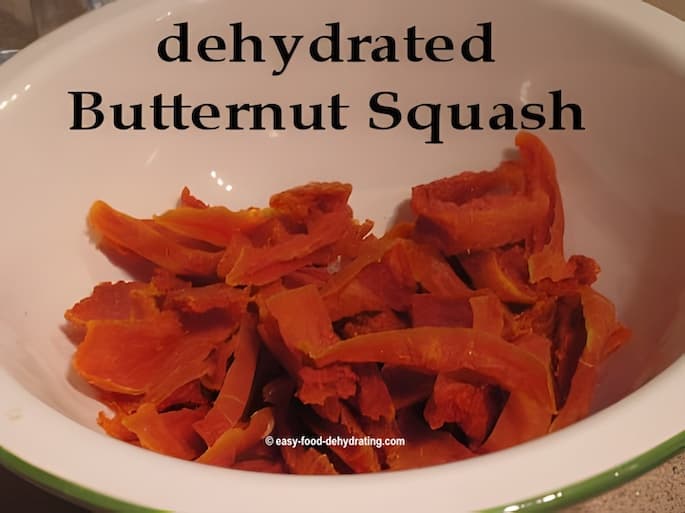
Waltham, Buttercup, or Pumpkin Squash—Which Dehydrates Best?
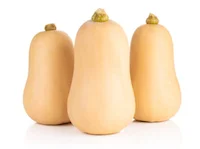
There is more than one type of butternut squash.
The most common type of butternut squash is the Waltham Butternut Squash.
This type of squash is large and oblong, with a yellow-orange color. It has a sweet, nutty flavor that makes it perfect for soups, stews, and pies.
Another type of butternut squash is the Buttercup Squash. This type of squash is smaller and rounder than the Waltham Butternut Squash. It has a greenish-yellow color and a sweeter, more delicate flavor. It is often used in baby food because of its smooth texture.
Finally, there
is the Pumpkin Squash. This type of squash is small and round, with an
orange-yellow color. It has a mild, sweet flavor that makes it perfect
for pies and other desserts.
Best Growing Conditions for Butternut Squash (Garden Tips)
The best areas to grow butternut squash are in warm climates with well-drained soils. Butternut squash is a warm-weather crop, so it does not do well in cold or damp conditions. Additionally, butternut squash needs full sun and well-drained soil to thrive.
So, if you're looking for the perfect spot to grow butternut squash, make sure it is in a warm climate with full sun and well-drained soil.
Butternut Squash vs Pumpkin: What’s the Real Difference?
Butternut squash is related to pumpkin. They are both members of the gourd family. Butternut squash is actually a type of winter squash, which is a group of squash that is characterized by its hard skin and sweet flesh.
Pumpkin is also a type of winter squash, but it is more commonly used for carving than for eating. So, while butternut squash and pumpkin are related, they are not the same.
Now you know how to dehydrate butternut squash and pumpkins, I'd love to hear from you! Contact me here and share your recipe!
Try This: Butternut Squash Soup Recipe with Your Dried Squash
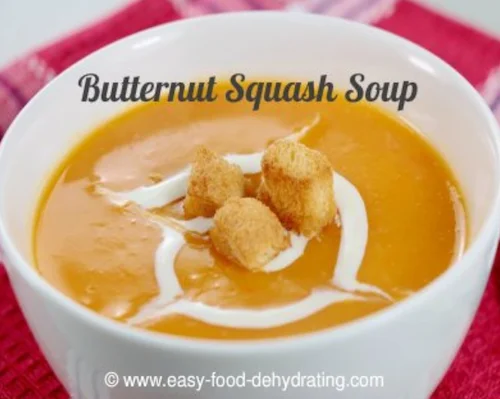
If you want to try your hand at making butternut squash soup, check out this Butternut Squash Soup recipe from AllRecipes.com
The photo is NOT from their website; use it for serving inspiration!
Your Butternut Squash Dehydrating Questions, Answered
Do I have to steam butternut squash before dehydrating?
Do I have to steam butternut squash before dehydrating?
Yes, steaming softens the squash and helps it dry more evenly. Frozen squash is already pre-blanched, so you can skip this step if using store-bought frozen cubes.
Can I use dehydrated butternut squash in soup?
Can I use dehydrated butternut squash in soup?
Absolutely! Just rehydrate it in hot water or broth for 10–15 minutes. It’s perfect for soups, stews, and purées.
Can dogs eat dehydrated butternut squash?
Can dogs eat dehydrated butternut squash?
Yes! Butternut squash is safe for dogs in small amounts and is a healthy fiber-rich veggie to include in DIY dog food. I use butternut squash to make my doggies "chicken chow" dog food. Read more about how to make dog food here.
Can I dehydrate puréed butternut squash?
Can I dehydrate puréed butternut squash?
Yes! Use fruit leather trays in your dehydrator. Spread the purée evenly and dry at 135°F until it’s leathery (about 6–8 hrs).
Can I powder dehydrated butternut squash?
Can I powder dehydrated butternut squash?
Absolutely! Blend dried squash into a fine powder and use it as a natural thickener for soups, stews, or even baby food.
What’s the best way to store dehydrated butternut squash?
What’s the best way to store dehydrated butternut squash?
Store in airtight glass Mason jars or vacuum-sealed bags in a cool, dark pantry. Use oxygen absorbers for long-term storage.
How long does dehydrated butternut squash last?
How long does dehydrated butternut squash last?
Properly stored in airtight jars or vacuum-sealed bags with oxygen absorbers, dehydrated butternut squash can last 12–18 months in a cool, dark pantry.
How do I dry butternut squash seeds for planting?
How do I dry butternut squash seeds for planting?
Scoop, rinse, dry, and bake seeds at 200°F for 2–4 hours. Store in a labeled envelope in a cool, dark place for up to 1 year.
Now that you know how to dehydrate butternut squash, you’ll never have to worry about wasting this delicious veggie again. It’s perfect for soups, stews, dog food, and even as a pantry snack when rehydrated.
Before you go, don’t forget to grab your free 5 Dried Food Recipes You’ll Actually Love PDF below—featuring carrot soup, minestrone, split pea soup, spicy beef jerky, and banana cinnamon rolls. They’re easy, tasty, and perfect companions to your newly dried squash!
Get 5 Dried Food Recipes You'll Actually Love
Here's where you can get your copy of our all new
5 Dried Food Recipes (That Actually Taste Great)
They're my all-time favorite easy dried food meals!
Get it here right now.
For Free!
Before You Go...
If you enjoyed this page, tap the ❤️ in the lower right-hand corner.
It saves this page to your Grow bookmarks so you can find it again later.
You’ll also see quick share buttons to copy the link, post to Facebook,
or save it straight to Pinterest.



















